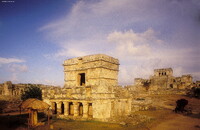| dc.coverage.spatial | Site: Tulum, Ruinas de, Quintana Roo, Mexico | en_US |
| dc.coverage.temporal | ca. 1200-ca. 1520 (creation) | en_US |
| dc.creator | unknown (Maya) | en_US |
| dc.date | 1200-1520 | en_US |
| dc.date.accessioned | 2013-05-28T19:56:58Z | |
| dc.date.available | 2013-05-28T19:56:58Z | |
| dc.date.issued | 1200-1520 | en_US |
| dc.identifier | 221436 | en_US |
| dc.identifier.other | archrefid: 489 | en_US |
| dc.identifier.uri | http://hdl.handle.net/1721.3/129383 | |
| dc.description | Temple of the Frescoes, general view (the walls inside the temple are painted with a mural honoring the "Diving God" and the goddess of corn. The Diving God is the most important god in Tulum.); It lies on the east coast of Quintana Roo about 40 km south-west of the island of Cozumel, on the summit of a limestone cliff about 12 m high, facing the Caribbean Sea. The name 'Tulum', which means 'wall' or 'fortification', is modern, but there is reason to believe that its ancient name was Zama, one of the Maya cities that, according to the chronicles, existed at the time of the Spanish Conquest. The conquistador Juan de Grijalva is generally credited with the discovery of Tulum during his expedition by sea along the coast of Quintana Roo in 1518. Source: Grove Art Online; http://www.groveart.com/ (accessed 2/14/2008) | en_US |
| dc.format.medium | stone | en_US |
| dc.rights | © Scott Gilchrist, Archivision, Inc. | en_US |
| dc.subject | Mesoamerican | en_US |
| dc.subject | Postclassic | en_US |
| dc.title | Tulum [site] | en_US |
| dc.title.alternative | Tulum, Ruinas de | en_US |
| dc.type | image | en_US |
| dc.rights.access | Licensed for educational and research use by the MIT community only | en_US |
| dc.identifier.vendorcode | 1A3-M-M-TU-B1 | en_US |
| vra.culturalContext | Maya | en_US |
| vra.technique | construction (assembling) | en_US |
| vra.worktype | excavation (site) | en_US |
| dc.contributor.display | unknown (Maya) | en_US |



